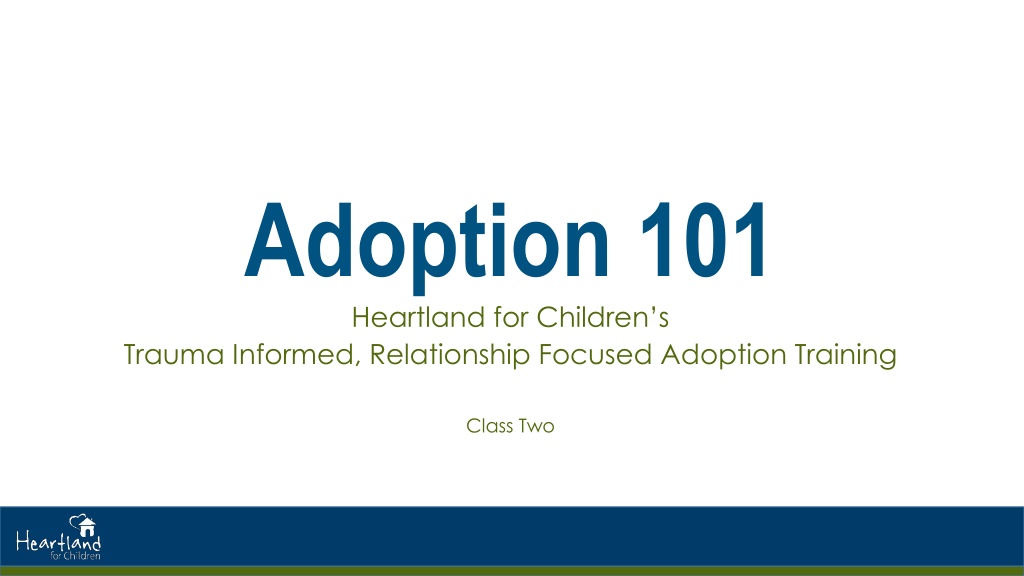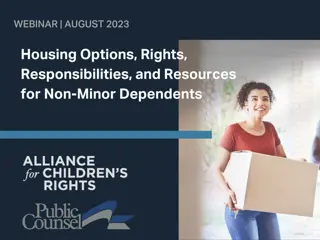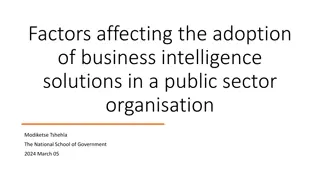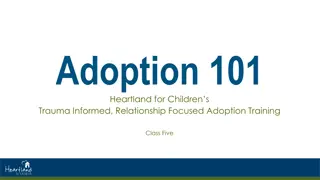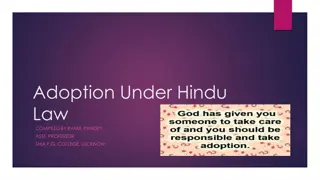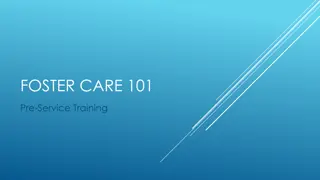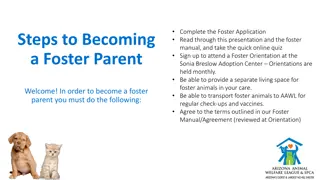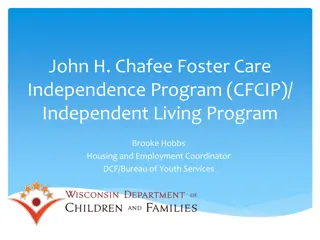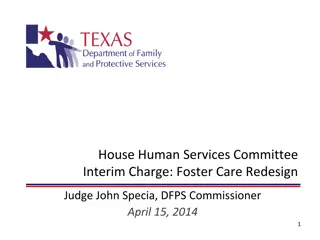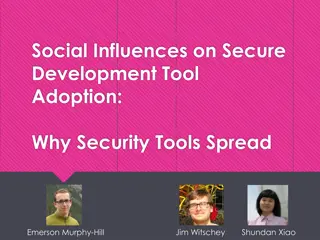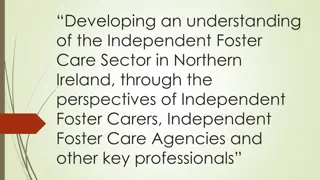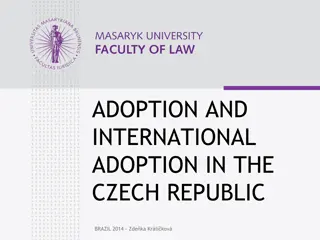Adoption and Foster Care Training Overview
Explore the journey of children entering the foster care system, with insights on trauma-informed care, relationship-focused adoption, and the process from initial hotline call to potential adoption. Learn about the roles of organizations like Heartland for Children and the steps involved in reunification or alternative permanent living arrangements. Understand the significance of timely case management decisions and pathways to achieving stability and permanency for children in care.
Download Presentation

Please find below an Image/Link to download the presentation.
The content on the website is provided AS IS for your information and personal use only. It may not be sold, licensed, or shared on other websites without obtaining consent from the author.If you encounter any issues during the download, it is possible that the publisher has removed the file from their server.
You are allowed to download the files provided on this website for personal or commercial use, subject to the condition that they are used lawfully. All files are the property of their respective owners.
The content on the website is provided AS IS for your information and personal use only. It may not be sold, licensed, or shared on other websites without obtaining consent from the author.
E N D
Presentation Transcript
Adoption 101 Heartland for Children s Trauma Informed, Relationship Focused Adoption Training Class Two
Welcome Back! Agenda for class two: Dependency System Overview Trauma 7 Core Adoption Clinical Issues Trauma Informed Care Connections Cultural Competence & LGBTQ
Dependency System Overview, How it all Starts It all begins with a phone call to the Abuse Hotline,1-800-96-ABUSE Reasons why children come into care Substance Abuse Physical Abuse Abandonment and/or Neglect Also could be for sexual abuse, emotional abuse, hazardous living conditions, etc. If the child/children cannot remain in the home safely, an alternative safe temporary placement is found that assumes the responsibilities of the parent. Relatives Non Relatives (friends, neighbors, etc.) Foster Care (last option)
Polk/Highlands/Hardee Counties Circuit 10 Central Region Heartland For Children Lead Community Based Care Agency One Hope United Children s Home Society Devereux Working in partnership with .Guardian Ad Litems, Dependency Court System, Department of Children and Families, etc.
Next Steps After Shelter. The initial goal is almost always to Reunify the child/children with their biological parents. Thus, the parents are given the opportunity to work on a series of tasks approved through the court that they must complete to obtain their child/children back. These tasks are related to reasons why the child came into care. Case Management works with the family to assist them with completion of these tasks and also ensures that the child s needs and well being are tended to.
Looking at the Big Picture To keep the child s best interest in hand, there are timeframes set up for the parents to complete tasks so that the children are not lingering in care without permanency. After about 9-12 months the case management agency will look at the progress in the case and decide if the primary goal should continue to be Reunification or an alternative goal. Other permanency goals are: Permanent Guardianship, Adoption, and Another Planned Living Arrangement. Adoption is the preferred goal if Reunification is not in the child s best interest. If the goal changes to Adoption, the process of Termination of Parental Rights initiates. This process can take anywhere from a couple months, to over a year, depending on the case.
Importance of Connections Why is it important to maintain connections? Who are we talking about? 5 Connections Activity
Importance of Valuing Culture, Race, Ethnicity, & Identity Culture is a system of values, beliefs, attitudes, traditions, and standards of behavior that governs the organization of people into social groups and regulates both group and individual behaviors. Dress, Traditions, Religion, Beliefs, Food, Music, Values, Geography, Recreation, Roles, Rules, Norms, Codes of Conduct (rules/standards consistent with your values), Education, Employment Race is a local geographical or global human population distinguished as a more or less distinct group by genetically transmitted physical characteristics or traits. Ethnicity is a grouping of people based on national origin, religious, linguistic, ancestral, or physical characteristics. Cultural identity involves a range of variables not only including ethnicity, acculturation and biculturality, and language, but also age, gender, socioeconomic status, sexual orientation, religious and spiritual beliefs, disabilities, political orientation, and health literacy, among other factors.
LGBTQ Every human has their own personal cultural and religious values and beliefs. Depending on the topic some of those beliefs and values maybe held very strongly. Unexamined personal values/beliefs and biases can negatively affect our ability to work effectively with others. This is especially true when working with youth who identify as LGBTQ. So What is LGBTQ anyway? L= Lesbian G= Gay B= Bi-sexual T= Transgender Q= Questioning
Heres what we know: 5-10% of general population identify as LGBTQ LGBTQ youth are estimated to make up a higher and disproportionate share of foster care and delinquency pools. LGBTQ youth identify SAFETY as their primary concern. 67% of LGBTQ youth who experience harassment/bullying never report it. 25% of these youth say they don t tell because they feel nothing will be done. Not all young people identify and many conceal that they are LGBTQ out of concern for their safety or privacy. 20-40% of homeless youth in the US identify as LGBTQ LGBTQ youth who experience rejection from their families have a far higher risk for major health and mental health problems as young adults. Compared with peers from families with no or low levels of family rejection they are: 8.4 times more likely to have attempted suicide 5.9 times more likely to report high levels of depression 3.4 times more likely to use illegal drugs 3.4 time more like to report having engaged in unprotected sexual intercourse. Why can t we just ignore it
Cultural Competence Cultural Competence encompasses several components: Ability to recognize the effects of our own culture on our values, beliefs, thoughts, communications, and actions. Ability to recognize how our own cultural lens affects our world view and can distort our interpretation of other cultures. Ability to learn about another culture from the people who know it best, and the willingness to be open to cultural change. Understanding that achieving cultural competence requires that we are life- long learners ; we can never become complacent that we fully understand culture. Understanding that culture is dynamic and continually changing. Recognizing how cultural differences may affect perception, communication, and our ability to interact with people whose cultural backgrounds are different from our own. Understanding cultural blindness and bias and how they contribute to racism, prejudice and discrimination. Ability to transcend cultural differences to establish trusting and meaningful relationships with person s from other cultures.
5 Essential elements of a culturally competent system of care Value Diversity To value diversity is to see and respect it s worth. A system of care is strengthened when they accept the people they serve from various backgrounds. Acceptance of the fact that each culture finds some behaviors, interactions, or values more important than others can help to have more successful interaction among the cultures. Capacity for Cultural Self-Assessment Must be able to assess self and have sense of own culture. Being Conscious of the Dynamics of Differences When a person from one culture interacts with someone from another culture, both may misjudge the other s actions based on learned expectations. Having an understanding of cross-cultural dynamics decreases chances for misinterpretation and misjudgment to occur. Institution of Cultural Knowledge System of care must sanction incorporation of cultural knowledge and supervisors must be able to provide cross-cultural supervision. Adaptation to Diversity A systems approach may be adapted to create a better fit between the needs of minority groups and services available. Becoming culturally competent is a developmental process for the individual and the system.
Our Children Our children all have various cultures, races, ethnicities, religions, ability status, and sexual orientation. When bringing a child into your home and your culture you need to recognize the child has a different perspective on life due to his/her experiences and also has different values, traditions, etc. It is important to respect the child s culture; however, you can still integrate some of your family s traditions, values, etc. in with the child s. Communicate! Ask the child What do you normally do on your birthday? Tell the child about what you do in your family, and ask what they would like to do. Ask the child What are some of your favorite meals? Tell them about what your family usually eats, and ask them if any of that sounds good to them.
Nature vs. Nurture Debate While experiences cannot change genes (DNA/genetics), it can change the epigenetic molecules, which is how our DNA is read. Science has shown in numerous studies how both nature and nurture, aka genetics and experiences , can both play a role in a child's life. Parents who embrace and support a child for who they are (genes/temperament), and encourage them to excel beyond with support, are the ultimate attuned parents. Their exceling will help them to learn to overcome any challenges related to their genes, but will not change their genes or temperament. Essentially this is backing up how we do not need to fix children or to attempt to mold them; but to accept them for who they are and integrate them into their adoptive family.
Removed Videos As you watch these videos, write down anything that stands out to you, resonates with you, or reminds you of the child your caring for journey.
Breaking the Cycle Keep the powerful messages from these Removed videos and the Josh Shipp video in your mind during your journey & share with friends and family! What stood out to you? What messages do you believe these videos communicate? In what ways do these videos connect with your experience caring for a child from a hard place (trauma)?
7 Hard Places of Trauma In Utero At Birth Immediately After Birth Abuse Neglect Single Incidence of Trauma System Effects
Trauma is Trauma is Trauma. No matter what the trauma was, it all imprints the brain the same. Even when in a safe environment, a child may not perceive their environment as safe due to their history of instability and trauma. One of the greatest factors in the healing process of trauma is RELATIONSHIP. This relationship must be unconditional, supportive, positive, long lasting, and nurturing.
Olivias Story: Olivia is a five year old biracial (Caucasian and African American) female. Her parents used substances (primarily heroin, alcohol, and marijuana) and there was frequent violence in their relationship. The family has moved four times during Olivia s first two years and was homeless once. Often Olivia s mother would leave her with friends or other relatives for brief periods. Olivia and her mother moved into a shelter when Olivia was three years old, but her mother returned to Olivia s father after six months. Two months later, the father was incarcerated for domestic violence incident and multiple charges for intent to dispute. The arrest occurred in front of Olivia. Olivia was removed from her mother s custody three months later after allegations of neglect and physical abuse. When Olivia was living with her biological parents, her house was unpredictable and with all the screaming and violence she was often scared. When scared, Olivia often hid or stayed still, hoping nobody would see her. When mom was using, she would sometimes be affectionate and loving but other times Olivia would need to work hard to obtain her mother s attention. The mother was very inconsistent in her affection and attention towards Olivia. Over the past year, Olivia has lived in three different foster homes. She was just placed in her current foster care home. The mother has not been complying with her case plan requiring her to get treatment for her substance abuse issue and mental health treatment for her Bipolar Disorder. In her foster care homes, Olivia is often described as challenging. While she is five years old chronologically, developmentally she functions similar to a toddler and needs constant support for daily tasks related to self-care. She is also very persistent in efforts to gain attention, whether positive or negative. However, when getting attention she often will reject it and scream I hate you or I want a new family. She has frequent temper tantrums including screaming, throwing things, profane language, and aggression. Lastly, she has a very difficult time at bedtime and often cries and clings to her foster mother when she tries to leave the room.
Lets Discuss Olivas Trauma Olivia is a five year old biracial (Caucasian and African American) female. Her parents used substances (primarily heroin, alcohol, and marijuana) and there was frequent violence in their relationship. The family has moved four times during Olivia s first two years and was homeless once. Often Olivia s mother would leave her with friends or other relatives for brief periods. Olivia and her mother moved into a shelter when Olivia was three years old, but her mother returned to Olivia s father after six months. Two months later, the father was incarcerated for domestic violence incident and multiple charges for intent to dispute. The arrest occurred in front of Olivia. Olivia was removedfrom her mother s custody three months later after allegations of neglect and physical abuse. When Olivia was living with her biological parents, her house was unpredictable and with all the screaming and violence she was often scared. When scared, Olivia often hid or stayed still, hoping nobody would see her. When mom was using, she would sometimes be affectionate and loving but other times Olivia would need to work hard to obtain her mother s attention. The mother was very inconsistent in her affection and attention towards Olivia. Over the past year, Olivia has lived in three different foster homes. She was just placed in her current foster care home. The mother has not been complying with her case plan requiring her to get treatment for her substance abuse issue and mental health treatment for her Bipolar Disorder. In her foster care homes, Olivia is often described as challenging. While she is five years old chronologically, developmentally she functions similar to a toddler and needs constant support for daily tasks related to self-care. She is also very persistent in efforts to gain attention, whether positive or negative. However, when getting attention she often will reject it and scream I hate you or I want a new family. She has frequent temper tantrums including screaming, throwing things, profane language, and aggression. Lastly, she has a very difficult time at bedtime and often cries and clings to her foster mother when she tries to leave the room.
Loss Control Issues Rejection 7 Core Adoption Clinical Issues Intimacy & Relationships Shame & Guilt Identity Grief
LOSS Without loss there is no adoption. How the loss is accepted, processed, and resolved can set the tone for the lifelong process of adoption. Each loss rests on top of others, sometimes piling high (placement changes, loss of siblings/friends/other family, etc.). Loss is ongoing, not a single event. It can come back up again during holidays, birthdays, or other reminders associated with the loss. It might not just be the loss of a person, but the loss of their culture, religion, birth history, family traditions, familiarity, etc. It is crucial to support a child s expression of their loss to help in the healing process. Expression can be through talking, play, art, journaling, etc. The more connections a child can keep (if healthy), the better to prevent further loss.
Rejection Feelings of loss are often heightened by keen feelings of rejection. Often when coping with loss comes questions of why me and wondering what they did to contribute to the cause of the loss. Thus, adopted children are often sensitive to the slightest hint of rejection, disapproval, or dismissal. Adoptive children, even at young ages, understand that to be chosen , they must first be unchosen . Often a lot of thoughts related to not only why their parents rejected them; but why their family rejected them too. Help the child to sort out the facts of their adoption from their feelings about the adoption. Being open and honest in an age appropriate manner can help them to understand. Feelings of loss and rejection can lead to low self esteem and can impact future relationships with friends, and into the future with intimate relationships. Behaviors may emerge in attempts to keep distance to protect themselves from future rejection (which they feel is inevitable). Parental COMMITMENT, different from attachment or even love, before the attachment becomes secure, is what holds adoptions together.
Guilt & Shame Often the sense of loss and rejection leads to accompanying feelings of guilt and shame, believing there is something wrong with them to experience such loss and rejection. From thoughts that they kicked too much in utero, was a difficult infant, had bad behaviors, told the family secret, etc. kids often think they are to blame. Often being involved in the foster care system, they get the idea that their parents are bad , and they think therefore so are they. Being in foster care is often something children will hide from their peers. It can come with a lot of questions, judgment and stigma even by adults. Helping them identify more positives than negatives is helpful, as well as helping them sort out their story and why they are in care.
Grief Every loss comes with grief. It can be difficult to mourn and grieve the loss permanently of a parent after adoption when adoption is viewed as such a joyous event. Please note that newborns can and do grieve! Children and teens look very different than functioning adults when they grieve, thus often cues of grief are overlooked. It may be in the form of physical symptoms (stomach aches, headaches, etc.), regression, disorganized, fearful, hyperactive, explosive behaviors, isolation, or withdrawal. These children are often expected to be relieved, grateful, and excited to be removed and safe. Yet, caregivers forget to put themselves in the child s shoes and what they may be feeling/thinking. Children in survival mode cannot take the time and energy to work through their loss issues until they feel safe and secure enough to let their guard down and work through it.
Identity Identity is what one is and what one is not. Sense of self is largely based on their early experiences and labels that others have used about them. Over time, these experiences and labels may become the filter through which they see themselves. Adoptee s lose an identity and then borrow one from their adoptive family. This leads to a lot of wondering about who they really are. If there is a lot of missing information about their birth family (especially in cases of unknown fathers and lack of information provided) there are often questions related to why they are and missing pieces to their identity.
Intimacy & Relationships All previously mentioned issues with adopted children may compile to lead to issues with future intimacy and relationships. Adopted persons have reported they are aware of holding back part of themselves in relationships, always cautious and watchful. Helping your child to move past their barriers and create close and secure attachments within the adoptive family can help with other future relationships.
Control Issues Many adoptees had little to no control over the loss of their family, placement in foster care home(s) and who they were placed with for adoption (depending on their age at adoption). Adoptees may lack internalized self control, leading to lower sense of self-responsibility. Important for adoptive parents to give children many age appropriate choices and responsibilities throughout development, avoiding power and control battles. Often need extra help with skill building to making choices/decisions as well as problem solving to help them gain a sense of control in their lives.
Olivias Story Thinking of the seven core adoption related issues, how do you think they will impact Olivia?
Thank you! Homework: Strengths & Needs! Think about your family/support system unit identify at least 3 STRENGTHS and 3 NEEDS Think about yourself personally identify at least 3 STRENGTHS and 3 NEEDS Homework: Psychotropic Medication Training Homework: ACE Survey & Resiliency
